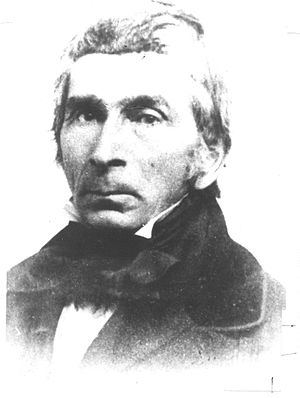Sheldon Peck
| Sheldon Peck | |
|---|---|
 |
|
| Born |
August 26, 1797 Cornwall, Vermont, United States |
| Died | March 19, 1868 (aged 70) Babcock's Grove present-day Lombard, Illinois, United States |
| Occupation | Artist Farmer Social activist |
| Movement |
Abolitionism Underground Railroad Racial equality Temperance movement Public education Women’s rights Pacifism |
| Spouse(s) | Harriet Cory (m.1825–1869; his death) |
| Children | John Peck Charles Peck George Peck Abigal Peck Alanson Peck Watson Peck Martha Peck Henry Peck Susan Elizabeth Peck Abigal Corey Peck Sanford Peck Frank Hale Peck (Unnamed infant) |
| Parent(s) | Jacob Peck Elizabeth Gibbs |
Sheldon Peck (August 26, 1797 - March 19, 1868) was an American folk artist, abolitionist, and social activist as well as an advocate for abolitionism, Underground Railroad, racial equality, temperance movement, public education, women’s rights, and pacifism. Peck’s portraiture – with its distinctive style — is a prime example of 19th century American folk art. While working as an artist, Peck was a conductor on the Underground Railroad.
Peck was born in Cornwall, Vermont, the ninth son of Jacob and Elizabeth Peck. Peck's ancestors were among the founders of New Haven Colony; his father worked as a blacksmith and served as a private in the Revolutionary War. Peck married Harriet Corey (1806-1887) in 1825 and the couple eventually had thirteen children. The Peck family moved to Jordan, New York in 1828 and lived there until moving westward to Chicago in 1836. A year later Peck finally settled in Babcock’s Grove (now Lombard) approximately twenty-five miles west of Chicago. On his 160 acres of farmland, Peck built a one and one half story timber-frame house (completed in 1839) that still stands today. Peck grew crops and raised Merino sheep, the latter being a way to produce the raw material for clothes without supporting the Southern-based cotton industry and its use of African slave labor.
No records exist to indicate that Peck received any formal art education. His work may have been influenced by William Jennys, a primitive portrait painter who was active in Vermont around the time Peck lived there. Peck also would have had access to art instruction texts that were housed in the library of the Cornwall Young Gentleman’s Society.
...
Wikipedia
